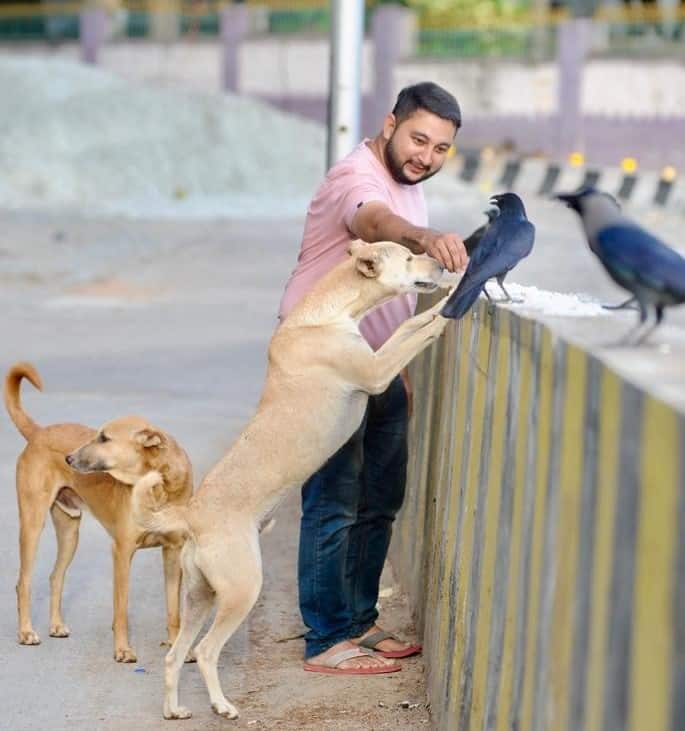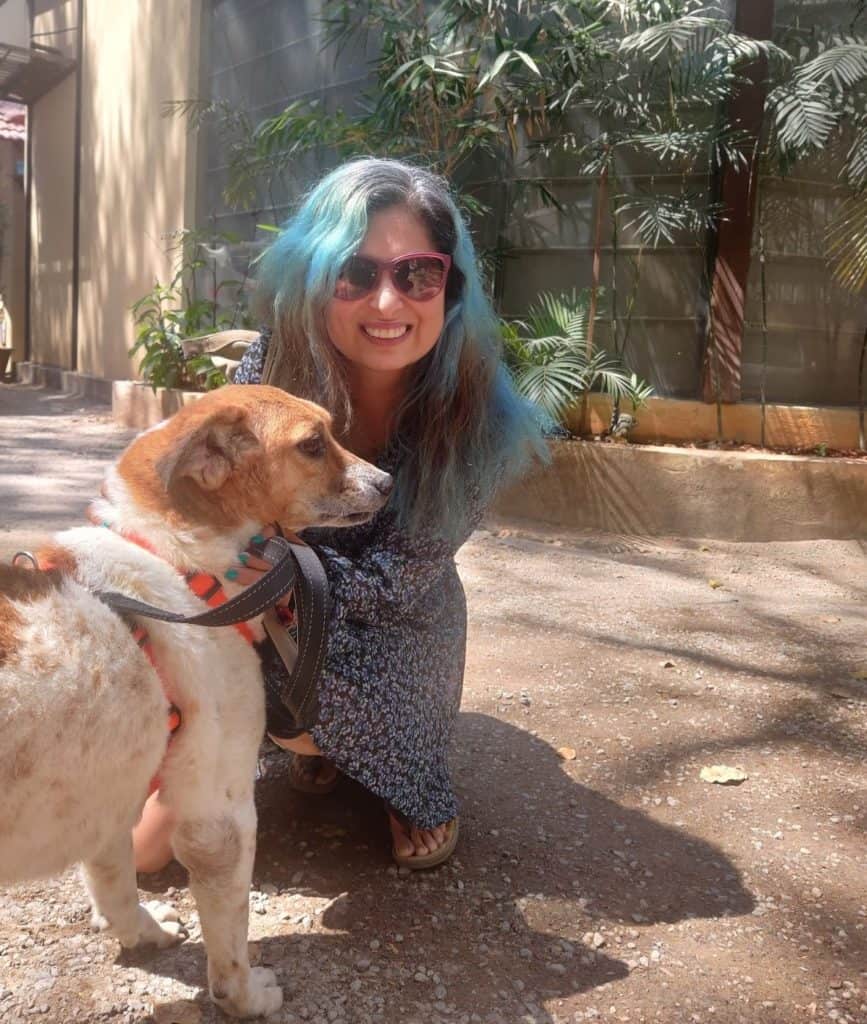Keys? Check. Wallet? Check. Dry Food, Wet food, Biscuits? Check. Spare Collar? Check. Phone. Check? Anxiety and love, Check?
And Priya Chetty Rajagopal is ready to go out on her morning walks around Chalukya Circle, in Bengaluru. First up, time for a daily roll call of all the neighbourhood street dogs – Ringtone, present, Chime, present, 4GMother, present. Then exchange pleasantries, talk gibberish, pet them, feed them till she moves on to the next lane towards the BSNL building.
Priya is part of Canine Squads, a locality-based group of community volunteers who work to ensure both animals and humans are cared for and safe in their neighbourhoods. The squads focus on vaccinations, feeding, rescuing and assisting with Animal Birth Control (ABC) programmes.
A 2019 survey revealed that Bengaluru has about 3.09 lakh street dogs across the 198 wards, but only 1.68 lakh were neutered.
“Overall, Bengaluru street dogs or community dogs as we prefer to call them are well taken care of,” says Chaithali Pisupati, Founder, The Goodness Factory and Member, Ulsoor Canine Squad. “Neighbourhood groups are key to ensuring the dogs’ wellbeing. The main challenge is to catch the dogs to get them sterilised in time.
How Canine Squads came to be
The idea of neighbourhood-level squads was first mooted by Priya Chetty Rajagopal, a CXO Search Consultant, dog lover and active citizen. “It all started nine years ago, with the Cubbon Park Active, a Whatsapp group of dog lovers,” says Priya. “They came together to attend and care for the community parkies (residents), as feeders, carers and rescuers and to keep each other posted”.
The trigger for the squad was when Blackie, a community dog from Cubbon Park was run over. “It was a horrible sight,” recalls Priya. “What was needed was a coming together of people to ensure that we knew what was happening to the Park dogs”.
Now, in her own neighbourhood Cunningham Road, an 84-member-strong group takes care of dogs around Cunningham Road, Vasanthnagar, Queens Road, Palace Road and sometimes Shivajinagar.
In 2012, through her CJ Memorial Trust, Priya also initiated the CJ Community Guardian Award, an annual recognition of animal welfarists, not only help the animals directly, by rescue, adoptions, feeding etc., but also work to educate their community.
Individual squads are volunteer-driven, democratic, decentralised, flat structures and are hyper local. Some Canine Squad volunteers are also members of the local RWA. Chaitali explains they act as the liaison and coordinate handling dog-human conflict issues. “Each group functions differently, there is heterogeneity, but all working for one cause and addressing a community in totality,” says Priya.
Read more: How to deal with stray dogs in Bengaluru
Squads are focussed on neutering, vaccinating, upkeep, rescue, adoption and care of the dogs within their jurisdiction. Requests for foster care, rescue, adoption etc. from other areas are directed to the respective groups. Members also respond to urgent cases like accidents, injuries, illness and cruelty cases. It helps that each squad member knows every single dog in the locality.
Vikash A Bafna, Member, Cunningham Canine Squad and Animal Rescuer, says: “The most important advantage of canine squads is that we don’t have to run around asking for help at other shelters or groups. All issues are handled at the local level”.

“Neutering and Vaccination is an ongoing effort,” says Chaitali. “The challenge usually is catching the dogs. We get excellent help from the Queen’s Road hospital. We also have excellent rescue saviours in Ulsoor Squad”.
The Ulsoor Canine Squad has 104 members, covering all of Ulsoor from Cambridge layout, East Parade church, Ulsoor Lake, Assaye Road and Gurudwara. They feed close to 75 dogs across the whole area though this number keeps changing. Chaitali, a member, explains how they function: “All dogs in the community are identified and named. When we were first initiated as a squad, we put reflective collars on all of the identified dogs with their name on them. Any new dog/puppy that someone notices is brought to the notice of the squad so that it can be identified. One of us then checks if the dog is fed/neutered & is assimilated into the dog list”.
Squads usually communicate on whatsapp groups. Some, like in Ulsoor, Indira Nagar, Hennur, Jayamahal, Frazer Town and Jayanagar use Facebook and Instagram to amplify their work. “The Bengaluru dog community is mostly connected through some kind of social media, mostly Facebook groups,” says Chaithali. “This helps in information dissemination and getting help as soon as it is possible”.
“Social Media has been empowering, as not only are people able to connect, but also share,” adds Priya.
“Recently, while feeding my BSNL puppy gang at 8am, I turned and saw Policeman Anand Patil of 4th Battalion KSRF behind me. He wanted to share his morning breakfast of biscuits and hard boiled eggs with little Peal. I broke the egg and fed to Peal. He fed her the biscuits. I then tell him about all the other BSNL pups Peal, Ping, Jingle Jangle, Chime, Ringtone, Tringaling, and their aunts 3G, 4G, and 5G. He chuckles at their names. Little Jingle runs from him (she obviously has a criminal past). And I walked away feeling touched. This is one example of daily kindness that one encounters during the morning rounds”
Priya Chetty Rajagopal
Cruelty a big issue
“Accidents and cruelty is a very big challenge,” says Chaithali. “Accidents happen mostly due to human negligence and it is very hard to get help to the dogs in time, and end up causing long term or permanent injury. We tried to educate people on safe driving and following traffic rules through a campaign. We spoke to the local traffic authorities and organised CCTVs, speed bumps etc. Another challenge is the human-animal conflict, many people still object to community dogs and their presence and barking around the area. Our members try and sensitise them with productive conversations and asking them to get involved in the feeding and neutering efforts so that this can be controlled to an extent”.

Read more: Let independent dogs be
The recent incident of Lara is a case in point. On January 26th, Adi Narayana Naidu deliberately ran over some sleeping community dogs near his house, killing a little dog named Lara. And Adi’s motive—“they bark and I don’t like them”. He ran over Lara’s chest repeatedly. Fatally crushed, Lara crawled into a ditch to suffer and die.
Lara’s death left an entire community of caregivers broken-hearted. But the heartbreak led to an FIR, and despite powerful connections, the accused’s cars were seized, and in an unusual first, he had to furnish a Rs 10 lakh bond before he was released.
Impact of canine squads
Today there are about 38 neighbourhood canine squads in Bengaluru and the numbers are rising. They forge strong relationships with ABC NGOS, BBMP, Animal Husbandry and Veterinary Services (AHVS) and Karnataka Animal Welfare Board (KAWB) allowing for quick access and speedy resolution. There is a conscious desire to ensure ABC/ARV, and pet parents are responsible to leash and pick up after their dog.
The other important success was the fact the Animal Husbandry & Veterinary Sciences (AHVS) team have made 24/7 high quality care available for all animals with the Super Specialty Queens Vet Hospital. This is only the second 24/7 specialty vet hospital in the country after Delhi. This was an outcome of the petition petition that was run four years ago
Recently, a note from the squads on chemical colour at Holi resulted in Society for the Prevention of Cruelty to Animals (SPCA) issuing a circular under PCA laws to ensure no colours used on animals, causing health issues.
Priya signs off by saying: “Remember, a bleeding heart does not mean a bleeding brain. We do apply our mind. The squads are a circle of influence, like a series of concentric circles”.
You can start a local Canine Squad
- Who can be a volunteer? Anyone who is presently involved in feeding or caring for local community dogs.
- Identify the key catchment areas within your area for community dogs: Demarcate the area, so that it is easier to manage.
- Carry out Dog Safety Audit: How many dogs are on the street? Do they have names? Does the neighbourhood feed them? If yes, would they like to be part of the network? How safe is the area? Is the community receptive? Are interventions such as awareness and counselling needed? What support is needed?
- Familiarisation with animal laws: Important for members to arm themselves with basic legal framework around animal cruelty, feeding street dogs, rules around relocation etc.
- Networking: Create a whatsapp group, keep the group updated on a daily basis of feeding schedules, rescue, animal birth control programs, adoption, fostering and general upkeep. Representation must include animal lovers, local officers, local veterinarians and specialist team members. Other recommended inclusion in the group- RWA members, ward committee members, police and elected representatives. The addition of both compassionate animal lovers, officials and specialist team members creates diversity and spread of effective outcome-oriented results, without losing out on warmth, we-feeling and community that motivates it.
- Identify local vets and hospitals: It is important to map out all vet clinics and hospitals and establish a working relationship.
- Common Branding: The branding – [Area] – of a Canine Squad is the key to success, as it helps create a uniform platform for organised work and allows sharing of best practices. Amplify work through Facebook and Instagram and remember ‘No Politics”.
- Create a hub and spoke model: Once local squads are activated it will be necessary to create a hub and spoke model with a few squad members serving as central squad admins. These members must be well versed with animal welfare laws and regulations. This is necessary for local squads to be able to escalate a complaint where necessary. Central Squad Admins as the hub and squads as the spokes. The groups are volunteer driven, and each contributes in their own way. Acceptance of the way of working is a first step.
- No Commercialisation: The squads are strictly non-commercial. The removal of any commercial element whatsoever confirms its integrity and purpose.
- Maintain Data: It’s important to maintain a database on the dogs and create metrics.
- Share Knowledge and Best Practices: Channelise group wisdom and knowledge management on neuter, abuse, rescue and cruelty.
Has anybody thought of how cruel street dogs can be. People cannot walk, motor alone on streets filled with street dogs. They attack two wheelers, so many people get seriuosly injured by them. They attack and severely injure kids. I think human security must be of utmost concern. If people like street dogs, let them take to their homes or construct places to take care of these animals. More than people being cruel to dogs, it is the dogs that are cruel and afflicting danger to humans. Everyone is afraid to take action against these dogs. Its high time people think of solutions to take care of both humans and dogs.
Please share contact details who can help in birth controlling of cats in my society. The number has increased drastically in last one year. We tried finding ngos but all in vain.
surabhijaiswal5@gmail.com
I am feeding 7 to 10 stray dogs once in every day in Bommasandra Ind area in E-city since last 1year + 1 month. Wish to join your volunteer team. Pls contact me … Philip.
We have a dog, street dog, Brownie, since his birth 7 years ago. He moves freely around our location, making many friends. He stays in our house most of the time, but keeps roaming around. Two days back we found him struggling to move, literally crawling. We took him to the Veterinary hospital near CBI office. The doctor has diagnosed Spondylitis deformation, saying the recovery is difficult. He is 7 years and 37kgs (obese). We need help for his rehabilitation